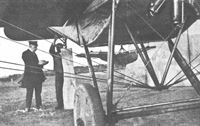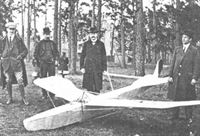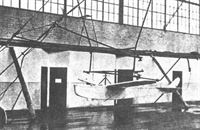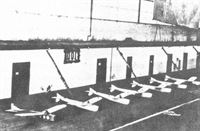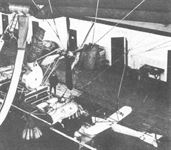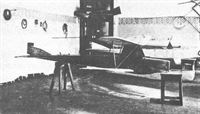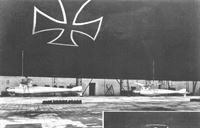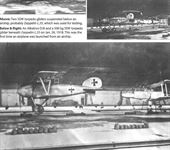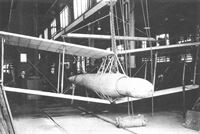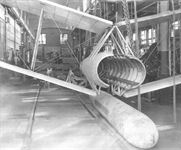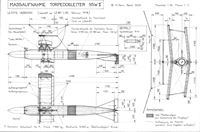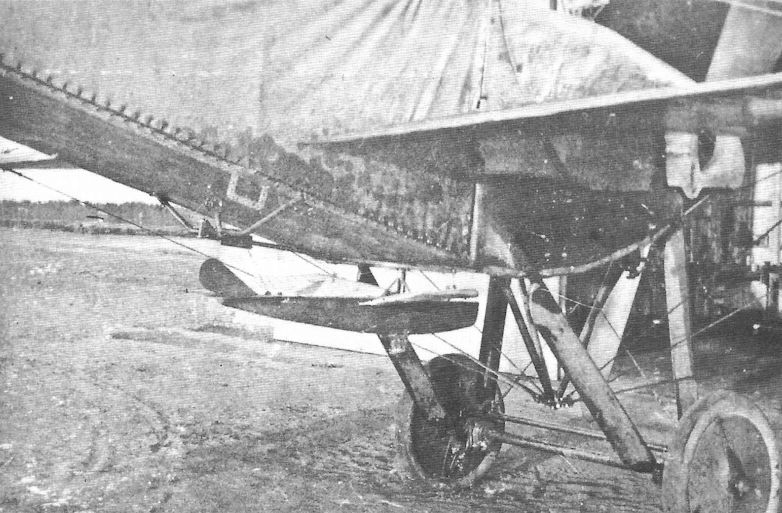
Описание
Страна: Германия
Год: 1915
Планер
J.Herris Siemens-Schuckert Aircraft of WWI (A Centennial Perspective on Great War Airplanes 12)
SSW Guided Missiles
Guided missiles are not the kind of 'aircraft' one normally associates with WWI, but SSW built and tested them and they are included here for their interest. In October 1914 Dr. Wilhelm von Siemens proposed remotely-controlled glide bombs, an air to surface missile. Work began that month and by January 1915 small models were under test.
Scale model glide-bombs were launched from towers, balloons, and a track built on the roof of the Siemens airship shed at Biesdorf in addition to launches from airships and airplanes. Initially the gliders' servo-controls were powered by batteries, but these heavy cells were soon replaced by propeller-driven dynamos that generated electricity. Guidance commands were transmitted from airships to the glide bombs by thin wires that unraveled from a spool after the glider was launched. After guidance commands the rudder returned to neutral but the elevator remained in the last position commanded. Many flight tests with gliders from 92 to 265 pounds weight were made from autumn 1915 to spring 1917.
Ships are difficult to hit with conventional bombs due to their ability to maneuver quickly after bombs are released, so they were a natural target for guided missiles. In mid-1916 torpedoes were chosen over bombs for the missile warhead because torpedoes allowed the maximum stand-off distance between the ship and the attacking aircraft. By autumn 1916 a method had been developed and tested to eject the torpedo just before the glider struck the water.
The size of the gliders was then increased significantly since torpedoes were to be carried, and night tests commenced. A flare was added to the glider so it could be seen in the dark and guided to its target. SSW conducted these tests throughout 1917. After more than 75 tests at Biesdorf, Zeppelins were provided to test larger, heavier gliders from higher altitude. From summer 1917 gliders weighing 660 pounds (300 kg) were launched from airship Z.XII in Hannover. In Autumn gliders of 1,100 pounds (500 kg) and 2,200 pounds (1,000 kg) were tested from Zeppelin L.35 at Juterbog and PL 25 at Potsdam.
After the older airships were dismantled L.35 was seldom available for the glider tests, and when a glider collapsed while suspended below L.35 in April 1918, further tests were suspended until the reason could be determined and fixed. Tests resumed in summer and the last test launch of a torpedo glider was made August 2, 1918. L.35 released the 1,000 kg biplane torpedo glider from 4,000 feet altitude at a target 4.6 miles (7.4 km) away. At an altitude of about 200 feet above the target and just after being commanded to turn into the target, the 5-mile long wire broke and the glider spun and crashed.
Meanwhile, SSW had designed monoplane torpedo gliders that would fit under the wings of bombers. However, the Armistice intervened before any of these could be test-launched and work on the torpedo-glider project was ended in December 1918.
- J.Herris Siemens-Schuckert Aircraft of WWI (A Centennial Perspective on Great War Airplanes 12)
Фотографии
-
J.Herris - Siemens-Schuckert Aircraft of World War I /Centennial Perspective/ (12)
SSW Biplane Torpedo Glider Guided Missile
-
J.Herris - Siemens-Schuckert Aircraft of World War I /Centennial Perspective/ (12)
SSW Monoplane Torpedo Glider Guided Missile
-
J.Herris - Siemens-Schuckert Aircraft of World War I /Centennial Perspective/ (12)
After being modified to eliminate its protruding belly, the SSW Bulldog, powered by one of the first 110 hp Siemens-Halske Sh.I counter-rotary engines, was used to launch scale gliders to develop shapes for the SSW guided missile program.
Другие самолёты на фотографии: Siemens-Schuckert Bulldog - Германия - 1914
-
J.Herris - Siemens-Schuckert Aircraft of World War I /Centennial Perspective/ (12)
Another view of a test glider mounted under the modified, rotary-powered SSW Bulldog before a test launch.
Другие самолёты на фотографии: Siemens-Schuckert Bulldog - Германия - 1914
-
J.Herris - Siemens-Schuckert Aircraft of World War I /Centennial Perspective/ (12)
Siemens test glider in 1915.
-
J.Herris - Siemens-Schuckert Aircraft of World War I /Centennial Perspective/ (12)
One of the early larger gliders hanging from the Parseval P.IV airship.The configuration is similar to the smaller gliders. The internal guidance package was powered by a battery, and later by a propeller-driven dynamo. Guidance signals were transmitted by thin wires several kilometers long.
-
J.Herris - Siemens-Schuckert Aircraft of World War I /Centennial Perspective/ (12)
Experimental glide-bombs in the Biesdorf airship shed in December 1915. Type 1b, the most common, had a wing area of 17.2 ft.2 and weighed up to 150 lb. A Type 1c is at far left.
-
J.Herris - Siemens-Schuckert Aircraft of World War I /Centennial Perspective/ (12)
One of the larger test gliders attached to an airship. The guidance system Siemens developed was command guidance by means of wires that unspooled from the glider.
-
J.Herris - Siemens-Schuckert Aircraft of World War I /Centennial Perspective/ (12)
As the gliders were enlarged, they were built as biplanes. Successful guided flights against ground targets were made from an airship in 1916.
-
J.Herris - Weird Wings of WWI /Centennial Perspective/ (70)
SSW torpedo-glider #2, weighing 300 kg, was successfully dropped from airship Z.XII in April 1917 after more than 75 glide-bombs were tested at Biesdorf. The cable spool is between the body and the upper wing.
-
J.Herris - Weird Wings of WWI /Centennial Perspective/ (70)
SSW glide-bomb #66 on the launching track at the SSW cable works. In October 1916 the 3.5 m long torpedo was first successfully released above the water of the Spree Canal.
-
J.Herris - Siemens-Schuckert Aircraft of World War I /Centennial Perspective/ (12)
Two SSW torpedo gliders suspended below an airship, probably Zeppelin L.35, which was used for testing.
-
J.Herris - Siemens-Schuckert Aircraft of World War I /Centennial Perspective/ (12)
An Albatros D.III and a 500 kg SSW torpedo glider beneath Zeppelin L.35 on Jan. 26, 1918. This was the first time an airplane was launched from an airship.
Другие самолёты на фотографии: Albatros D.III - Германия - 1916
-
J.Herris - Siemens-Schuckert Aircraft of World War I /Centennial Perspective/ (12)
SSW torpedo-glider #7 showing the torpedo in flight mode at left. On August 2,1918 this glider flew 7.4 km after being released from Zeppelin L.35 at an altitude of about 1,200 meters. Just after being commanded to turn into the target at about 60 meters altitude, the 7.4 km long guidance wire broke and the glider spun and crashed near the target. This was the last torpedo glider launched from a Zeppelin.
-
J.Herris - Siemens-Schuckert Aircraft of World War I /Centennial Perspective/ (12)
SSW torpedo-glider #7 showing the torpedo in release mode.
-
G.Haddow, P.Grosz - The German Giants /Putnam/
This SSW monoplane torpedo glider weighed 1,000 kg and was developed after the final Zeppelin test in August 1918. The monoplane torpedo glider was intended for use from Zeppelins and, with its lower profile, could also be carried under large bombers. The pod on top of the body carried the spool of guidance wire. Power for the controls was provided by the wind-driven generator mounted above the nose, behind which can be seen the container for the spool of guide wire. Further Zeppelin tests were planned but the Armistice intervened.
-
J.Herris - Weird Wings of WWI /Centennial Perspective/ (70)
This advanced monoplane torpedo glider had a dynamo in the tail to power the guidance system and the control wires ran out through the hollow dynamo shaft.




